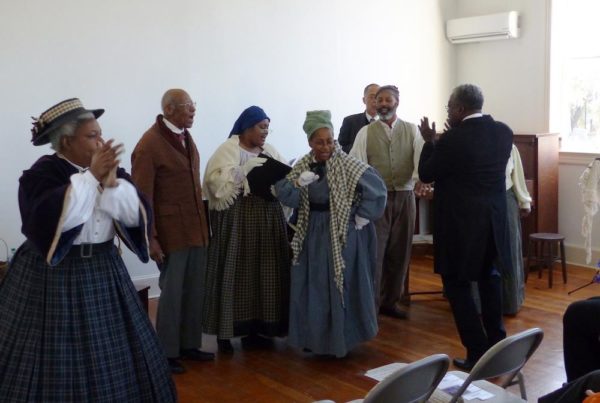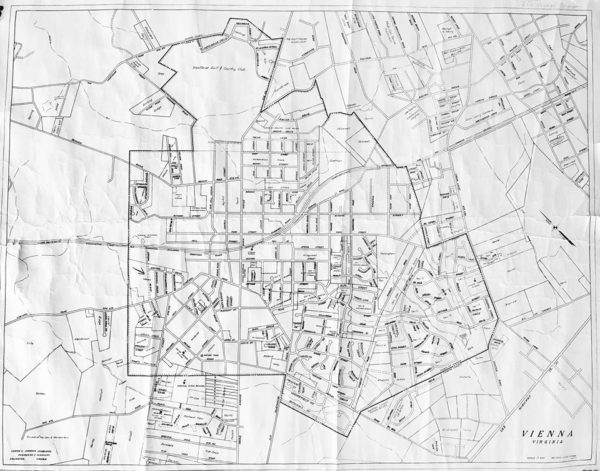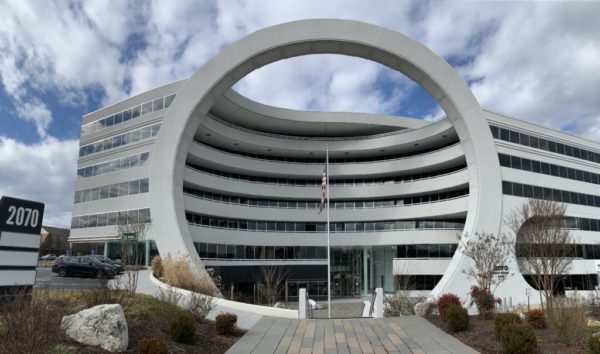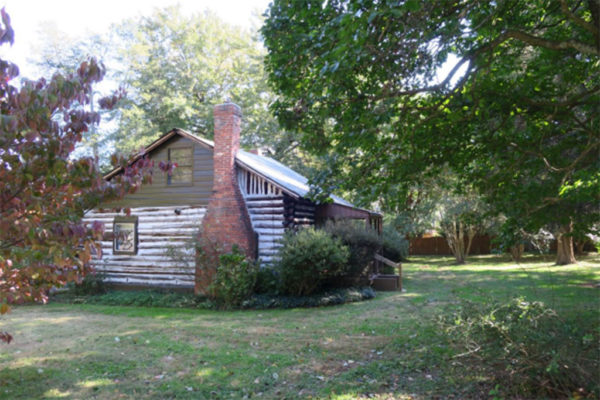The Weekly Planner is a roundup of interesting events coming up over the next week in the Tysons area.
We’ve scoured the web for events of note in Tysons, Vienna, Merrifield, McLean and Falls Church. Know of any we’ve missed? Tell us!
Tuesday (May 7)
- Town of Vienna Election — 6 a.m.-7 p.m. at the Vienna Community Center (120 Cherry Street SE.) — There is a competitive race for the Town Council in Vienna, mainly focusing on the scale of new developments.
- “The Guest Book” Reading and Signing — 7:30-9:30 p.m. at Barnes & Nobles (7851 Tysons Corner Center) — Sarah Blake, author of the historical novel The Guest Book, will read from the book and sign copies at the Tysons Corner Center Barnes and Noble.
Thursday (May 9)
- Innovation Breakfast: The Opportunity in Opportunity Zones — 8-10:30 a.m. at Valo Park (7950 Jones Branch Drive) — The Community Foundation for Northern Virginia is hosting a business breakfast looking at opportunity zones, tracts of land targeted by state and federal governments for economic development. The breakfast will look at where they exist and what can be accomplished with them. Registration is $40 and includes breakfast.
- Urban Forest Perfume Making Workshop — 5:30-7:30 p.m. at Brandbox Lounge (Tysons Corner Center) — For Mother’s Day, the Urban Forest Perfume Company is setting up a workshop looking at the art of plant-based perfumes. Participants will get a class in understanding synthetic versus plant ingredients, perfume notes and basic formulas. Light food and wine will also be served.
- Vienna Community Brainstorming on Public Parking in Commercial Corridor — 6-7 p.m. at the Town Hall Council Chambers (127 Center Street S.) — The Town Business Liaison Committee and Mayor Laurie DiRocco will host a community conversation about parking. This is an opportunity to gather further feedback from business owners and refine solutions proposed at the March 14 community meeting.
- The Civil War in Northern Virginia — 7:30-9 p.m. at the Patrick Henry Library (101 Maple Ave E.) — Historian William S. Connery, author of “Civil War Northern Virginia 1861” will host a discussion of notable events and battles throughout Northern Virginia after the firing on Fort Sumter.
Friday (May 10)
- Young Adult Dungeons and Dragons — 3:30-6 p.m. at the Patrick Henry Library (101 Maple Ave E.) — A group of players are putting together an all-experience levels Dungeons and Dragons group aimed at grades 7-12.
Saturday (May 11)
- All the Way Live — 1-2 p.m. at the Alen Theatre (1234 Ingleside Ave.) — The history-through-hip-hop children’s show is coming to the Alden Theatre in the McLean Community Center. Tickets range from $10-$15.
Sunday (May 12)
- Mother’s Day Brunch — 10 a.m.-3 p.m. at Cheesetique Mosaic (2985 District Ave.) — Cheesetique in the Mosaic District is hosting a Mother’s Day event featuring a mimosa bucket, green eggs and ham, french toast, and lobster mac and cheese. The shop will also be open with special gifts for mothers. Reservations are encouraged.
- Mother’s Day Brunch — 11 a.m.-3 p.m. at Inca Social (2670 Avenir Place) — Inca Social is hosting a Latin-style brunch on Sunday with cocktails and special brunch items. Children under 6 years old eat for free.
- Listen to Your Mother’s Jokes — 5-7 p.m. at Tysons Biergarten (8346 Leesburg Pike) — In a special comedy show, the Tysons Biergarten is hosting local standup comedians who are also mothers. Seating starts at 5 p.m. with the show starting at 6 p.m. Tickets are $10.
Photo via Facebook
Vienna’s Windover Heights Historic District is a little secluded, but on Sunday, April 28, the neighborhood is throwing open its doors to the public for its annual A Walk on the Hill.
The small neighborhood is located just northwest of the Maple Avenue near Lawyers Road. This year marks the 40th anniversary of Windover Heights being designated as a historic district.
The festival is planned to include live music and photography exhibits, in addition to tours of the historic neighborhood. During the celebration, visitors are also invited to stroll through 50 participating yards and landscaped gardens.
Several homes in the neighborhood date back to the late 19th century, with the local history going back further with stories of Union soldiers using the area as a cavalry outpost during the Civil War.
According to town documents, notable historic spots on the tour include:
- 214 Lawyers — The original First Baptist Church was built here in 1887 by the black community on land deeded for $1 by Major O. E. Hine, Vienna’s first mayor. The material was from the Union Army barracks of the Civil War. This was the first church in Vienna and was also used as a school until the 1890s.
- The Barn at Windover — The barn was originally part of the Salsbury dairy farm on the hill. Handmade wooden pegs have continued being used in the building’s preservation and the original design is maintained.
- The West End Cemetery — The land was deeded in 1884 by Capt. Harmon Salsbury and his second wife, Susannah Freeman, to the small black community that had grown up around the Salsbury farm. Many of the tombstones date to the turn of the century and before. Thomas and Daniel West, prominent black citizens, are buried here. In 1987 Historic Vienna, Inc. rededicated the cemetery as a historic Vienna landmark.
The event is free and open to the public, with local residents providing punch and cookies during the celebration. Parking for the event is available at the Green Hedges School and at the Vienna Arts Society (243 Church Street NW).
Photo via Facebook
The Washington Revels, a musical group from Silver Spring, is planning a concert in McLean this weekend for a second annual celebration of a local church’s history.
Tomorrow (Saturday), the group is planned to hold a performance in the Historic Pleasant Grove Church at 8641 Lewinsville Road in McLean from 3-5 p.m. The concert is free and open to the public.
The church was established in 1896 by the descendants of freed slaves. Services at the church were discontinued in 1968, but today the site holds a museum and hosts several public events.
According to the group’s website, the performance will feature traditional music from African American congregations in the late 19th century and early 20th century.
The program is planned to open with a short presentation on the history of the church and the surrounding area, with refreshments and a social hour after the show.
Photo via Facebook
Students at a private school in Tysons got to examine and touch artifacts from American history in a unique lesson on World War II.
The traveling “Operation Footlocker” exhibit stopped by an AP U.S. history class at the BASIS Independent McLean (BIM) yesterday (Tuesday), according to the school.
The program by the National WWII Museum sends a footlocker full of 15 artifacts from WWII — like letters home, sand collected from Normandy and Iwo Jima, or wartime magazines — to schools in order to facilitate hands-on educational experiences.
The footlocker opened in BIM included a 1944 high school yearbook, wooden toys, and a U.S. Army field manual. The footlockers come with cotton gloves for handling the artifacts and a manual to explain the significance of each object.
“We’re grateful to the National World War II Museum for this fantastic learning opportunity that allows our students to touch, feel and see this moment in history with genuine artifacts,” said Tiffany Conroy, head of school for BIM in the press release.
Falls Church a city almost exactly 100 years older than the first daguerreotype cameras. It was a recruiting station for the American militia in the Revolutionary War and the scene of minor skirmishes throughout the American Civil War.
But even so, it’s a city that’s gone through numerous changes over the last 80 years of Fairfax County’s aerial photography.
Unlike most of nearby Tysons, Falls Church already has the visible bones of a small city by the photography from 1937. The familiar street network is in place, with several homes situated along the intersection of Broad and Washington Streets.
By 1953, the Winter Hill neighborhood was built, and the cookie-cutter pattern of American suburbia was starting to stamp down on fields around the town.
The aerial photography is spotty after that, with no coverage in the 1960s or 70s, but returns in 1980, when downtown Falls Church’s transition to strip malls and small shopping centers was in full swing. New streets, like Annandale Road, also connected businesses along Washington Street to homes and other businesses along Broad Street.
There was less change between 1980 and 1990 though, when most the changes took place at the western end of the downtown area where new apartments and new shopping centers were built closer to Lee Street or with new northeast of Broad Street.
Like nearby Vienna, the pace of development in Falls Church slowed dramatically after 1990. Very little of the town’s shape and structure changed between 1990 and 2007, and less between 2007 and 2017.
One of the most visible changes in downtown Falls Church was the construction of the Harris Teeter in 2016, the first grocery store in the city’s downtown in three decades.
Previous Then and Now features from around the area include:
(Updated 8:30) — A new exhibit in Vienna’s Freeman Store & Museum showing the town’s expansion in the 1950s is scheduled for a grand opening Sunday (March 10).
The museum’s website says the new exhibit will feature stories of how the town grew in the ’50s through the twin lenses of the opportunities and challenges of the decade.
The store and museum is managed by Historic Vienna Inc., a local non-profit organization dedicated to preserving and promoting local history.
According to the Historic Vienna Inc. newsletter:
Remember hula hoops, Barbie dolls, play doh, and matchbox cars? Remember Patsy Cline, Elvis, Little Richard, and the Kingston Trio? How about Leave It to Beaver, Gunsmoke, I Love Lucy, and The Ed Sullivan Show? The Korean War? segregation? Vienna experienced the 50s in all its good, bad, and ugly. Come to the Freeman Store to experience Vienna in the 50s through an exciting multimedia exhibit.
In the early part of the decade, Vienna’s Maple Avenue was still a street that ran mostly through fields with sporadic residences along the roadside, but over time the next few decades, the town would gradually become more and more developed.
According to the Town of Vienna website:
In 1940, Vienna was still a small, quiet, rural town with a population of 1,237 and remained virtually untouched by the metropolitan character of the nation’s capital. The town began to take on a new look in the 1950s when many businesses started to move from the old commercial section on Church Street to Maple Avenue. The post-World War II rush to the suburbs brought a burgeoning of population to Northern Virginia, almost 10,000 new residents to Vienna alone, their new houses blending with those of an earlier era.
In 1954, the first of Vienna’s modern shopping centers was opened. More shopping centers followed in quick succession along a widened Maple Avenue in an attempt to keep up with the influx of newcomers who bought homes in the town’s new subdivisions. Older residents recall with nostalgia the Victorian homes and the maple trees that lined Maple Avenue before it was widened in 1958.
The other current exhibit in the museum is dedicated to the Women’s Suffrage Movement, highlighting the 100th anniversary of the League of Women Voters.
Photo via Town of Vienna
For all its faults, it’s hard to say Tycon Courthouse doesn’t stand out.
More locally known as the “Toilet Bowl” or “Stargate” building, Tycon Courthouse on Route 123 just west of Leesburg Pike is most notable for it’s over seven-story tall ring in the front of the building.
But there was a time where the building, labeled the ugliest in Virginia in Business Insider’s 2018 list of ugliest buildings in every state, was once the height of local architecture. It was, at one point, the largest office building in Tysons and the first structure to include massive structure parking, able to accommodate a then-record 900 cars.
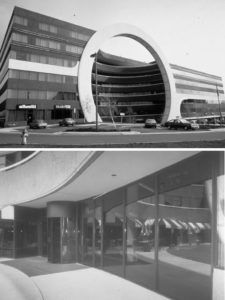 It was built in 1983 in the middle of a “screaming architecture” fad — a Washington Post article at the time said the buildings were designed to be their own advertisements. They were reflective of peak Reagan-era style, where notability was more important than pleasing aesthetics. Architects Volker Zinser and Barry Dunn were credited with the project.
It was built in 1983 in the middle of a “screaming architecture” fad — a Washington Post article at the time said the buildings were designed to be their own advertisements. They were reflective of peak Reagan-era style, where notability was more important than pleasing aesthetics. Architects Volker Zinser and Barry Dunn were credited with the project.
There are several urban rumors about the project, like that it was designed to look like an “O” for the Olivetti Company, or the lenses of a Nikon camera, but an interview with Zinser at the time said he was inspired by a book about 19th-century French architects who designed projects that explored geometric volumes.
In keeping with the style, Zinser said the fact that the building was being talked about was more important than what people were calling it.
The screaming architecture fad was centered around Fairfax County. Experts at the time called it medieval, noting that businesses were grabbing spaces and turning them into private fortresses.
The Blade Runner-esque Tysons Office Center on Route 7 and Gallows Road, sometimes called the “Flash Cube” building, and Tycon Towers, the 17-story “shopping bag,” were other local examples of this design.
Tycon Courthouse in the 1980s photo via Bonstra Haresign Architects
Fairfax County’s aerial photography can offer a view of the startling growth of some some parts of the area, charting Merrifield‘s growth from a lonely drive-in theater to today’s Mosaic District, changes to Tysons Galleria and the commercial properties around Route 7, and Tysons East’s transformation from suburbs to an urban center.
But McLean’s story is more like Maple Avenue’s, where rapid growth has been followed by decades of stagnation.
An ongoing effort to update zoning for downtown McLean, called the McLean Community Business Center (CBC), has faced pushback from some local residents who say the plans will transform McLean into a new Tysons-style development.
While the town of McLean was founded in 1902, aerial photography shows that even as late as the 1960s there wasn’t a developed center of town. The first developments in the CBC, like McLean House Condominiums in the northeast corner and Langley Shopping Center a little south of that, show up in photography from the 1970s.
Between then and 1990, much of the area along Old Dominion Drive was developed and new shopping centers bloomed at the southern edge of downtown McLean.
But in all of the photography between 1990 and 2017, that development grinds to a halt. At several of the McLean CBC meetings, locals lamented that McLean didn’t really have a “sense of place” and that much of the downtown was defined by gas stations on every corner and vacant buildings.
The plans for the CBC call for changing some of the transportation routes through the downtown McLean to make the area more pedestrian friendly and allowing new, mostly residential and commercial developments downtown.
Merrifield has always been anchored by its movie theater. While Fairfax County’s aerial photography shows the site’s growth from fields to an urban center, the theater has been there since some of the earliest photos.
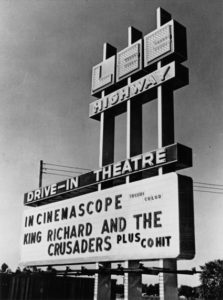 In photography from before 1960, Merrifield is mostly fields and farmland. But in 1954, the Washington area’s largest drive-in theater, the Lee Highway Drive-In, opened at the site. That’s the cone-shaped development in the middle of the aerial photography.
In photography from before 1960, Merrifield is mostly fields and farmland. But in 1954, the Washington area’s largest drive-in theater, the Lee Highway Drive-In, opened at the site. That’s the cone-shaped development in the middle of the aerial photography.
The theater featured a 50×120′ CinemaScope screen and a rotunda-style dining area. At its capacity in 1983, the drive-in could fit 1,353 cars.
The drive-in is still visible in the 1976 photography, with other development sprouting up nearby. In 1984, however, the drive-in was closed and replaced with a multiplex theater nearby. Like the drive-in at its heyday, the new theaters that opened were state-of-the-art.
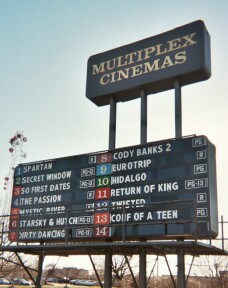 But by the mid-2000s, the once modern multiplex was showing its age, like the drive-in had before it. The site gained some notoriety in 2005 after a man leaving the theater was attacked by several assailants, one of whom wielded a machete and cut three fingers off the man’s hand.
But by the mid-2000s, the once modern multiplex was showing its age, like the drive-in had before it. The site gained some notoriety in 2005 after a man leaving the theater was attacked by several assailants, one of whom wielded a machete and cut three fingers off the man’s hand.
In 2009 the site’s owner, National Amusements, sold the site and plans began to emerge for a more pedestrian-friendly urban center today known as the Mosaic District. Photography from 2011 shows the area mid-development; in 2012 the Mosaic District opened with a mix of handpicked local boutiques and national retailers.
Prior to that, Rep. Gerry Connolly described Merrifield as a “waste” in a New York Times article on the emerging development.
Mr. Connolly… is familiar with Merrifield’s past and present. He remembers thinking to himself, “What a waste of land,” after being elected in 1995 to the Fairfax County board of supervisors. “We have this aging movie theater that’s surrounded by acres of surface parking,” Mr. Connolly said.
In fall 2012, the Angelika Film Center opened an 8-screen theater in Mosaic District, continuing Merrifield’s movie legacy established more than half a century earlier.
Past and Present is a Tysons Reporter series looking at locations in our area as they’ve changed over the last century. Check out our articles for Tysons Corner Mall, Tysons Galleria/Leesburg Pike, Tysons East, and Maple Avenue.
The log cabin at 307 Cabin Road SE has survived for over 80 years, but it couldn’t survive development plans to subdivide the lot it sits on.
Last night (Monday), the Vienna Town Council voted to approve a subdivision of the cabin that would ultimately result in its destruction. But like the Planning Commission at their meeting in November, the Town Council couldn’t find a compelling reason to deny the application, which cabin-aside would be an otherwise unremarkable request.
The cabin is not a designated historic location, which means it has no legal protections. Members of the Town Council noted that it was one of several buildings in the town that have some historic relevance but not enough to protect or have an impact on the local community.
There is also the issue that the building is also in poor shape, with rotting wood and a fragile structure. The owner of the site told the council that the building could not be saved.
“This does mean things to the community,” Councilmember Carey Sienicki. “We heard from citizens that this is an important structure. Unfortunately, it was in disrepair. It can’t be moved.”
Instead, some of the logs from the site may be salvaged as it is taken apart. The council also proposed working with Historic Vienna to preserve pieces of the building and erect a plaque, either at the site or at a display the Freeman Store and Museum.
Members of the council lamented that while the developer American Signature Properties had said they were amenable to historic research and preservation as long as it didn’t interfere with development plans, representatives of the group at earlier meetings concerning the cabin had showed little interest in any form of preservation.
Town Attorney Steve Briglia told council members that there was very little the town could do to force the developer to engage in preservation measures for the cabin.
Photo via Town of Vienna




